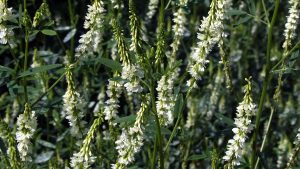#167: Clitocybe odora
Clitocybe odora is easily recognized by its pale blue-green color and its distinctive anise-like odor. The mushroom is edible, but not very many people go looking for it. C. odora is sometimes called the “Aniseed Funnel” or “Blue-Green Clitocybe,” but most people refer to it by its scientific name.1,2,3
Description
C. odora is a small to medium-sized mushroom, growing only 2-8cm tall and 2-11cm wide. The mushroom is umbrella-shaped with a central stipe and gills underneath a circular pileus. Its pileus starts out convex with an inrolled margin. As the mushroom matures, the pileus becomes concave to somewhat vase-shaped and the margin unrolls and becomes wavy and somewhat irregular. Frequently, the margin develops dark lines as the mushroom gets older. C. odora occasionally has a slight umbo, or rounded, raised area over the center. The cap is blue-green to greenish to grayish, sometimes with a paler center. These deep colors quickly fade, especially if the mushroom is exposed to direct sunlight or dry weather. The pileus is mostly smooth but can be covered in tiny hairs. Usually, the hairs lie flat against the cap surface and give the mushroom a streaked appearance.1,3

p-anisaldehyde (or 4-methoxybenzaldehyde, to the IUPAC)9 is the primary chemical that gives C. odora its anise-like aroma.4
On the underside of the pileus, the gills radiate out from the central stipe. There is not much space between the gills, which are considered close to crowded. The gills are attached to slightly decurrent, which is typical of mushrooms in the genus Clitocybe. Most collections of C. odora feature gills that are whitish, sometimes tinged with pink or the cap color. Spores produced by the gills of C. odora leave a whitish to pinkish spore print.1,3
The stipe is smooth and whitish, though it is often covered in very small hairs. For the most part, the stipe remains the same width its entire length, though it sometimes curves and enlarges toward the base. The base is always covered in dense, white fibrils of mycelium. At first, the stipe is firm and solid. However, it can become spongy and hollow as the mushroom ages. Inside the mushroom, the flesh is firm and whitish.1,3
The most striking feature of C. odora is its strong aniseed odor and flavor.1,3 Clitocybe mushrooms can be very difficult to tell apart from one another, but the combination of blue-green color and strong anise-like odor makes C. odora easy to pick out.1 The mushroom’s distinctive aroma is primarily due to the chemical p-anisaldehyde, which is present in the flesh of C. odora.4
Varieties
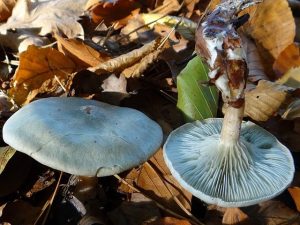
This C. odora specimen has gills colored about the same as the cap. By Jerzy Opioła [CC BY-SA 3.0], via Wikimedia Commons
Similar Species
When C. odora is older, it can fade and lose its scent. If this happens, you can easily mistake the mushroom for many other pale Clitocybe species.1 If you plan to eat your C. odora collection, make sure to pick only young species that are blue-green and have an anise odor. This should prevent confusion with similar Clitocybe species.2
Ecology
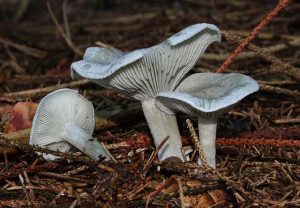
C. odora decomposes debris of hardwoods and conifers. By H. Krisp [CC BY 3.0], via Wikimedia Commons
The mushroom grows in temperate forests across the Northern Hemisphere.2 In the United States, it is most common west of the Rocky Mountains. C. odora var. pacifica grows in the Pacific Northwest region of North America. The mushrooms appear from summer through fall in temperate zones and in fall through winter in warmer climates.1,3
Edibility
C. odora is considered an edible species, though it is not commonly collected for the table. The main draw for eating this mushroom is its anise aroma.2,6 I find that it is also somewhat peppery, making it a truly unique edible species. You can use the mushroom in various dishes that do not drown out its flavor. Consider using it in risottos, soups, and sauces for mild fish. You can also dry the mushroom, grind it into a powder, and use it like a spice.2 Not everyone considers C. odora edible: RogersMushrooms suggests the mushroom might be poisonous and recommends against eating it.3
Taxonomy
C. odora belongs to the core group of gilled mushrooms (Agaricales) and is placed in the family Tricholomataceae.5 Tricholomataceae is an unnatural grouping of gilled mushrooms with a white spore print that haven’t been assigned to a proper family. Basically, mycologists throw all the agarics that don’t fit into other taxa into Tricholomataceae.7 The genus Clitocybe (Michael Kuo says you should say Clitocybe like you say “I toss a bee”) contains agarics with a pale spore print, with attached or decurrent gills, and without a partial veil.8
| Kingdom | Fungi |
| Phylum | Basidiomycota |
| Subphylum | Agaricomycotina |
| Class | Agaricomycetes |
| Subclass | Agaricomycetidae |
| Order | Agaricales |
| Family | Tricholomataceae |
| Genus | Clitocybe |
| Species | Clitocybe odora (Bull.) P. Kumm.5 |
See Further:
http://www.mushroomexpert.com/clitocybe_odora.html
http://www.first-nature.com/fungi/clitocybe-odora.php
http://www.rogersmushrooms.com/gallery/DisplayBlock~bid~5800.asp
Citations
- Michael Kuo. Clitocybe odora. MushroomExpert.Com (2007). Available at: http://www.mushroomexpert.com/clitocybe_odora.html. (Accessed: 17th November 2016)
- Pat O’Reilly. Clitocybe odora (Bull.) P. Kumm. – Aniseed Funnel. First Nature Available at: http://www.first-nature.com/fungi/clitocybe-odora.php. (Accessed: 17th November 2016)
- Roger Phillips. Clitocybe odora. RogersMushrooms Available at: http://www.rogersmushrooms.com/gallery/DisplayBlock~bid~5800.asp. (Accessed: 17th November 2016)
- Rapior, S., Breheret, S., Talou, T., Pélissier, Y. & Bessière, J.-M. The anise-like odor of Clitocybe odora, Lentinellus cochleatus and Agaricus essettei. Mycologia 94, 373–376 (2002).
- Clitocybe odora. Mycobank Available at: http://www.mycobank.org/BioloMICS.aspx?Table=Mycobank&Rec=5741&Fields=All. (Accessed: 18th November 2016)
- Michael Wood & Fred Stevens. California Fungi—Clitocybe odora. The Fungi of California Available at: http://www.mykoweb.com/CAF/species/Clitocybe_odora.html. (Accessed: 17th November 2016)
- Michael Kuo. The Tricholomataceae. MushroomExpert.Com Available at: http://www.mushroomexpert.com/tricholomataceae.html. (Accessed: 18th November 2016)
- Michael Kuo. Clitocyboid Mushrooms. MushroomExpert.Com Available at: http://www.mushroomexpert.com/clitocyboid.html. (Accessed: 18th November 2016)
- 4-Methoxybenzaldehyde | C8H8O2 – PubChem. Pubchem Available at: https://pubchem.ncbi.nlm.nih.gov/compound/4-Methoxybenzaldehyde. (Accessed: 17th November 2016)

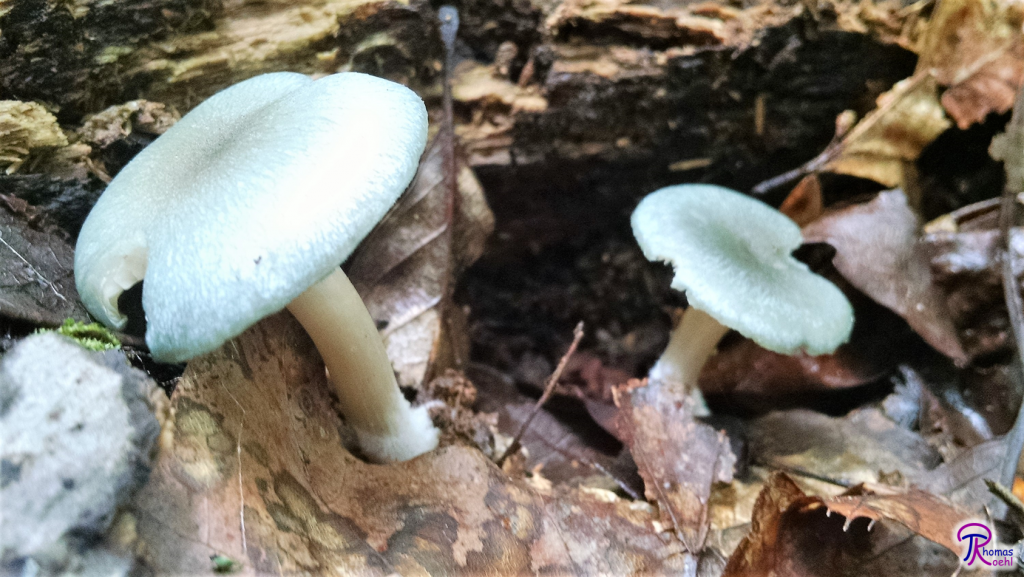

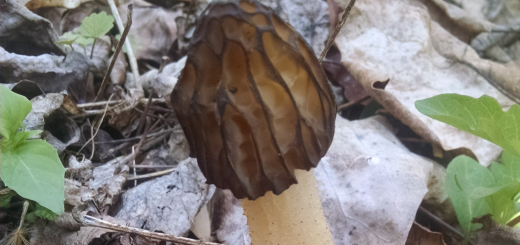
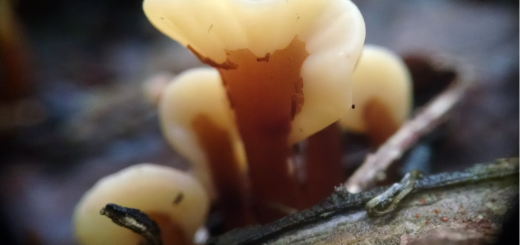





![#011: Characteristics of Kingdom Fungi [Archived]](https://www.fungusfactfriday.com/wp-content/themes/hueman/assets/front/img/thumb-small-empty.png)

